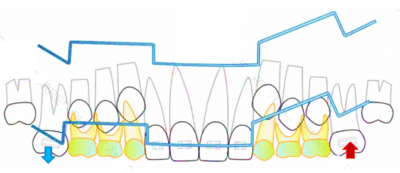Introduction
In recent times, dental occlusion science has undergone a significant shift. While formal studies have concentrated on chewing, pronunciation, and appearance, research has established a direct link between occlusion, emotions, stress, and the autonomic nervous system. Consequently, the importance of occlusion in maintaining overall body health has increased significantly. In addition, the focus has shifted from correcting malocclusion during a specific growth stage to reassessing early treatment as a means of lifelong health maintenance.
Malocclusion Development – Roles of Vertical Dimension (VD) and Occlusal Plane (OP) in Development of Malocclusions
Observation of the occlusal plane of individuals showing average maxillofacial growth and development reveals that the occlusal plane gradually flattens, the mandible rotates forward, and the mandibular plane gradually decreases and adapts further forward. On the other hand, in Class II cases, the occlusal plane, especially the posterior occlusal plane (POP), hardly changes and remains steeply inclined. The mandible rotates backward, making anterior adaptation difficult. In Class III cases, the maxillary molars’ vertical height increases significantly, the POP flattens, and the mandible adapts anteriorly with significant anterior rotation. These results indicate that controlling the occlusal plane is the key to success in the orthodontic treatment of malocclusion.

In Class I growth, the vertical dimension of the molars gradually increases, and the occlusal plane gradually flattens. Conversely, the mandible rotates forward, and the angle of the mandibular plane decreases. b) Human maxillofacial growth is produced by forward rotation of the mandible in response to the increase in the dental vertical dimension and the change in the occlusal plane. c) In Class II growth, there is an insufficient increase in dental vertical dimension and adaptation with a tendency toward backward rotation. d) In Class III growth, there is a significant increase in molar height diameter and increased forward adaptation due to mandibular rotation, resulting in skeletal growth with mandibular prognathism.
To effectively prevent malocclusion at an early stage, it is crucial to consider the growth and developmental history of the craniofacial complex in Homo sapiens
- Our approach involves correcting the occlusal vertical dimension (VD) and occlusal plane (OP) to ensure proper teeth and jaw alignment.
- We aim to correct mandibular malposition during the early stages of development to prevent further issues.
- Our treatment approach is based on biological principles, prioritizing the health and function of the patient's teeth and jaw.
- We also protect the TMJ from overloading by providing occlusal support.
In the past, orthodontic treatment focused on treating occlusion mechanically, often leading to unstable outcomes. We should apply biological principles to malocclusion early treatment: Adaptation and Compensation.
Adaptation: The ability of organisms to adapt and sustain life through physiological responses to environmental changes.
Compensation: The body’s biological responses aim to optimize functionality despite structural defects.
Our body employs three mechanisms to compensate for skeletal discrepancies: vertical compensation, dentoalveolar compensation, and articular compensation.
A vertical occlusal guidance device (overlay. Fig. 2) is recommended for growing individuals to address vertical maxillofacial disharmony early. This device is fixed to the molars and can actively improve the occlusal height diameter and mandibular position, promoting secondary growth of the mandibular condyle. The overlay has several advantages, including its ability to improve the occlusal height and anterior-posterior mandibular position without needing removal. Its effect can also be maintained until the lateral teeth are replaced. Additionally, the 2 x 4 device (Fig. 3) can achieve vertical control of the anterior and molar areas that cannot be improved with an overlay.
Early treatment of the Class-III Low angle malocclusion
During the development of the dentition, a deficiency in the vertical dimension of occlusion may result in a Class-III-malocclusion with a closed mandibular rotation as a sign of vertical de-compensation. Correcting the occlusal vertical dimension using simple treatment procedures like overlay normalizes the occlusion during later development. Due to the bite raising, the mandible adapts to a posterior position, and the dentition erupts into a Class I relationship. Correcting the occlusal vertical dimension can reorient the developmental direction abnormal tendency from the early mixed dentition period. Figure. 4 shows the schematic representation of the mechanism of action of a resin overlay.
Fig. 4: Case of anterior crossbite (Class III skeleton)
(a) The case of an anterior crossbite was treated with a resin overlay on the mandibular molars using a vertical compensatory response to the height of the occlusal plane.
(b) to change the fulcrum of mandibular rotation and further steeply reconstruct the occlusal plane (c), dynamically changing the direction of maxillofacial cranial growth (d).

Case 1
Case of anterior crossbite with mandibular lateral deviation to the left. (Fig. 5, 6) was treated with a resin overlay on the mandibular molars using a vertical compensatory response to the height of the occlusal plane.



Case 2
Case of mandibular lateral deviation to the right. (Fig. 8, 9) It was treated with a resin overlay on the maxillary right molars and asymmetrical activation of the utility arch. The maxillary right molar is extruded, while the left is intruded


Conclusion
Early treatment is to successfully bring out the adaptability of the body and help the individual acquire reasonable functions under the conditions.
The essential therapeutic points are vertical dimension control, occlusal plane reconstruction, and physiological mandibular position.
To Learn the Concepts Described in this Blog , please click here
Roberto Velasquez, D.D.M, M.Sc., Ph.D., Miles Guyton, D.D.S., Heike Kraemer, Dr. med. dent., M.Sc.
2024-2026: Starts March, 13 – 16 & May 15 – 18, June 19 – 22, September 11 – 14, December 4 – 7
Continues every Mar/Jun/Sep/Dec; 2025-26 TBD


